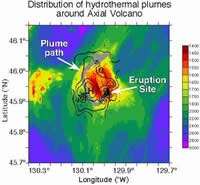| |
| |

This figure illustrates our present understanding
of the distribution of hydrothermal plumes around Axial Volcano. The
bathymetry of Axial is described by the color contours. Black lines
are contours indicating the mass of hydrothermal particulates in the
water overlying the volcano's summit. Large gray arrow indicates the
most likely path of particles discharged from the eruption site and
carried around the summit by the local current flow. |
|
R/V Wecoma - CTD Cruise
Science News
Science
Report - Wednesday, July 25, 2001
Position - 46 05.974' N / 129 56.011' W
Chief Scientist Ed Baker
Today is our last at Axial Volcano this year, and as we
prepare
to steam south to our next working area we are thinking about rivers in
the deep sea. If that sounds like we are thinking too much about the landscape
back home, remember that water in the ocean, at every depth, is always
flowing somewhere. There are great ocean rivers that dwarf the Mississippi
or the Amazon--the Gulf Stream is familiar to almost everybody--but lesser
streams and rivulets are everywhere.
One
of the interesting questions we have tried to address in studying Axial
is the effect that this mountain exerts on the flow of the deep-sea currents
that surround it. Besides studying this current-bathymetry interaction
for its own sake, we are also interested in mapping the current flow over
the summit because it will help us make quantitative estimates of the
hydrothermal discharge here. Hydrologists measure the flow and particle
concentration in rivers to gauge the mass of silt transported downstream.
We are attempting the same technique here, but the size, flow, and even
the path of our river is frustratingly difficult to pin down.
The
figure illustrates some of what we have learned so far. Overlying the
color bathymetry of Axial itself are black lines that mark the total distribution
of particles in the plumes overlying Axial (these data are from last year,
2000, but the distribution will be little different in 2001). You can
see that the densest concentration of contours overlies the eruption site,
where the plume is most concentrated. Around the summit the lines are
mostly circular, since the plume concentrations decrease with distance
from the active venting at the eruption site. If you look carefully, however,
you will also see that plume concentrations tend to be higher to the south
and west of the summit (the "H" on the map indicates a concentration
high to the west of the summit). This distribution, combined with direct
measurements of currents we have made here, suggests that there is a circular
flow around the summit, here illustrated by the large gray arrow that
curls clockwise around the volcano. By improving our understanding of
the "Axial river" we will better know how hydrothermal venting
here effects not only the volcano summit itself but also the chemistry
and life of the surrounding ocean.
|
|

